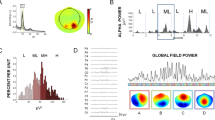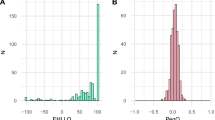Abstract
Previous studies showed that scale-free structures and long-range temporal correlations are ubiquitous in physiological signals (e.g., electroencephalography). This is supposed to be associated with optimized information processing in human brain. The instantaneous alpha frequency (IAF) (i.e., the instantaneous frequency of alpha band of human EEG signals) may dictate the resolution at which information is sampled and/or processed by cortical neurons. To the best of our knowledge, no research has examined the scale-free dynamics and potential functional significance of IAF. Here, through three studies (Study 1: 25 participants; Study 2: 82 participants; Study 3: 26 participants), we investigated the possibility that time series of IAF exhibit scale-free property through maximum likelihood based detrended fluctuation analysis (ML-DFA). This technique could provide the scaling exponent (i.e., DFA exponent) on the basis of presence of scale-freeness being validated. Then the test–retest reliability (Study 1) and potential influencing factors (Study 2 and Study 3) of DFA exponent of IAF fluctuations were investigated. Firstly, the scale-free property was found to be inherent in IAF fluctuations with fairly high test–retest reliability over the parietal-occipital region. Moreover, the task manipulations could potentially modulate the DFA exponent of IAF fluctuations. Specifically, in Study 2, we found that the DFA exponent of IAF fluctuations in eye-closed resting-state condition was significantly larger than that in eye-open resting-state condition. In Study 3, we found that the DFA exponent of IAF fluctuations in eye-open resting-state condition was significantly larger than that in visual n-back tasks. The DFA exponent of IAF fluctuations in the 0-back task was significantly larger than in the 2-back and 3-back tasks. The results in studies 2 and 3 indicated that: (1) a smaller DFA exponent of IAF fluctuations should signify more efficient online visual information processing; (2) the scaling property of IAF fluctuations could reflect the physiological arousal level of participants.






Similar content being viewed by others
Data Availability
The datasets of Study 1 and Study 2 are available from the corresponding authors upon reasonable request subject to a formal data sharing agreement with Prof. Fei Gao and Prof. Hua Wei. The dataset of Study 3 are available at http://doc.ml.tu-berlin.de/simultaneous_EEG_NIRS/.
Code Availability
The MATLAB code here is available from the corresponding author, Prof. Fei Gao, upon reasonable request.
References
Adrian ED, Matthews BHC (1934) The Berger rhythm: potential changes from the occipital lobes in man. Brain 57:355–385
Ahern GL, Schwartz GE (1985) Differential lateralization for positive and negative emotion in the human brain: EEG. Spectr Anal Neuropsychol 23:745–755. https://doi.org/10.1016/0028-3932(85)90081-8
Berthouze L, James LM, Farmer SF (2010) Human EEG shows long-range temporal correlations of oscillation amplitude in Theta, Alpha and Beta bands across a wide age range. Clin Neurophysiol 121:1187–1197. https://doi.org/10.1016/j.clinph.2010.02.163
Botcharova M, Farmer SF, Berthouze L (2013) A maximum likelihood based technique for validating detrended fluctuation analysis (ML-DFA). https://arXiv.org/1306.5075
Botcharova M, Berthouze L, Brookes MJ, Barnes GR, Farmer SF (2015) Resting state MEG oscillations show long-range temporal correlations of phase synchrony that break down during finger movement. Front Physiol 6:183. https://doi.org/10.3389/fphys.2015.00183
Cecere R, Rees G, Romei V (2015) Individual differences in alpha frequency drive crossmodal illusory perception. Curr Biol 25:231–235. https://doi.org/10.1016/j.cub.2014.11.034
Chen B et al (2015) Individual variability and test-retest reliability revealed by ten repeated resting-state brain scans over one month. PLoS ONE 10:e0144963. https://doi.org/10.1371/journal.pone.0144963
Ciuciu P, Abry P, He BJ (2014) Interplay between functional connectivity and scale-free dynamics in intrinsic fMRI networks. Neuroimage 95:248–263. https://doi.org/10.1016/j.neuroimage.2014.03.047
Cohen MX (2014) Fluctuations in oscillation frequency control spike timing and coordinate neural networks. J Neurosci 34:8988–8998. https://doi.org/10.1523/JNEUROSCI.0261-14.2014
Delorme A, Makeig S (2004) EEGLAB: an open source toolbox for analysis of single-trial EEG dynamics including independent component analysis. J Neurosci Methods 134:9–21. https://doi.org/10.1016/j.jneumeth.2003.10.009
Dickinson A, DiStefano C, Senturk D, Jeste SS (2018) Peak alpha frequency is a neural marker of cognitive function across the autism spectrum European. J Neurosci 47:643–651. https://doi.org/10.1111/ejn.13645
Gabard-Durnam L, Tierney AL, Vogel-Farley V, Tager-Flusberg H, Nelson CA (2013) Alpha asymmetry in infants at risk for autism spectrum disorders. J Autism Dev Disord 45:473–480. https://doi.org/10.1007/s10803-013-1926-4
Haegens S, Cousijn H, Wallis G, Harrison PJ, Nobre AC (2014) Inter- and intra-individual variability in alpha peak frequency. NeuroImage 92:46–55. https://doi.org/10.1016/j.neuroimage.2014.01.049
Hahn T et al (2012) Randomness of resting-state brain oscillations encodes Gray’s personality trait. Neuroimage 59:1842–1845. https://doi.org/10.1016/j.neuroimage.2011.08.042
Hardstone R, Poil SS, Schiavone G, Jansen R, Nikulin VV, Mansvelder HD, Linkenkaer-Hansen K (2012) Detrended fuctuation analysis: a scale-free view on neuronal oscillations. Front Physiol 3:450. https://doi.org/10.3389/fphys.2012.00450
He BJ (2011) Scale-free properties of the functional magnetic resonance imaging signal during rest and task. J Neurosci 31:13786–13795. https://doi.org/10.1523/JNEUROSCI.2111-11.2011
He BJ (2014) Scale-free brain activity: past, present, and future. Trends Cogn Sci 18:480–487. https://doi.org/10.1016/j.tics.2014.04.003
Hu L, Peng W, Valentini E, Zhang ZG, Hu Y (2013) Functional features of nociceptive-induced suppression of alpha band electroencephalographic oscillations. J Pain 14:89–99. https://doi.org/10.1016/j.jpain.2012.10.008
Ihlen EAF (2012) Introduction to multifractal detrended fluctuation analysis in Matlab. Front Physiol 3:141
Jann K, Koenig T, Dierks T, Boesch C, Federspiel A (2010) Association of individual resting state EEG alpha frequency and cerebral blood flow. NeuroImage 51:365–372. https://doi.org/10.1016/j.neuroimage.2010.02.024
Jia H, Yu D (2019) Attenuated long-range temporal correlations of electrocortical oscillations in patients with autism spectrum disorder. Dev Cogn Neurosci 39:100687. https://doi.org/10.1016/j.dcn.2019.100687
Jia H, Peng W, Hu L (2015) A novel approach to identify time-frequency oscillatory features in electrocortical signals. J Neurosci Methods 253:18–27. https://doi.org/10.1016/j.jneumeth.2015.05.026
Jia H, Li Y, Yu D (2018) Attenuation of long-range temporal correlations of neuronal oscillations in young children with autism spectrum disorder Neuroimage: Clin 20:424–432. https://doi.org/10.1016/j.nicl.2018.08.012
Kello CT, Brown GDA, Ferrer-i-Cancho R, Holden JG, Linkenkaer-Hansen K, Rhodes T, Van Orden GC (2010) Scaling laws in cognitive sciences. Trends Cogn Sci 14:223–232. https://doi.org/10.1016/j.tics.2010.02.005
Klimesch W (1999) EEG alpha and theta oscillations reflect cognitive and memory performance: a review and analysis. Brain Res Rev 29:169–195. doi:https://doi.org/10.1016/S0165-0173(98)00056-3
Lei X, Zhao Z, Chen H (2013) Extraversion is encoded by scale-free dynamics of default mode network. NeuroImage 74:52–57. https://doi.org/10.1016/j.neuroimage.2013.02.020
Linkenkaer-Hansen K, Nikouline VV, Palva JM, Ilmoniemi RJ (2001) Long-range temporal correlations and scaling behavior in human brain oscillations. J Neurosci 21:1370–1377. https://doi.org/10.1523/JNEUROSCI.21-04-01370.2001
Linkenkaer-Hansen K et al (2007) Genetic contributions to long-range temporal correlations in ongoing oscillations. J Neurosci 27:13882–13889. https://doi.org/10.1523/JNEUROSCI.3083-07.2007
Montez T et al (2009) Altered temporal correlations in parietal alpha and prefrontal theta oscillations in early-stage Alzheimer disease. Proc Natl Acad Sci USA 106:1614–1619. https://doi.org/10.1073/pnas.0811699106
Nelli S, Itthipuripat S, Srinivasan R, Serences JT (2017) Fluctuations in instantaneous frequency predict alpha amplitude during visual perception. Nat Commun 8:2071. https://doi.org/10.1038/s41467-017-02176-x
Nieber D, Schlegel S (1992) Relationships between psychomotor retardation and EEG power spectrum in major depress. Neuropsychobiology 25:20–23. https://doi.org/10.1159/000118804
Peng CK, Havlin S, Stanley HE, Goldberger AL (1995) Quantification of scaling exponents and crossover phenomena in nonstationary heartbeat time series. Chaos 5:82–87. https://doi.org/10.1063/1.166141
Peng W, Hu L, Zhang Z, Hu Y (2012) Causality in the association between P300 and alpha event-related desynchronization. PLoS ONE 7:e34163. https://doi.org/10.1371/journal.pone.0034163
Samaha J, Postle BR (2015) The speed of alpha-band oscillations predicts the temporal resolution of visual perception. Curr Biol 25:2985–2990. https://doi.org/10.1016/j.cub.2015.10.007
Samaha J, Bauer P, Cimaroli S, Postle BR (2015) Top-down control of the phase of alpha-band oscillations as a mechanism for temporal prediction. Proc Natl Acad Sci USA 112:8439–8444. https://doi.org/10.1073/pnas.1503686112
Sampat MP, Whitman GJ, Stephens TW, Broemeling LD, Heger NA, Bovik AC, Markey MK (2006) The reliability of measuring physical characteristics of spiculated masses on mammography british. J Radiol 79:S134–S140. https://doi.org/10.1259/bjr/96723280
Shew WL, Plenz D (2013) The functional benefits of criticality in the cortex. Neuroscientist 19:88–100. https://doi.org/10.1177/1073858412445487
Shin J, von Lühmann A, Kim DW, Mehnert J, Hwang HJ, Müller K-R (2018) Simultaneous acquisition of EEG and NIRS during cognitive tasks for an open access dataset. Sci Data 5:180003. https://doi.org/10.1038/sdata.2018.3
Smit DJA et al (2011) Scale-free modulation of resting-state neuronal oscillations reflects prolonged brain maturation in humans. J Neurosci 31:13128–13136. https://doi.org/10.1523/JNEUROSCI.1678-11.2011
Zietsch BP, Hansen JL, Hansell NK, Geffen GM, Martin NG, Wright MJ (2007) Common and specific genetic influences on EEG power bands delta, theta, alpha, and beta. Biol Psychol 75:154–164. https://doi.org/10.1016/j.biopsycho.2007.01.004
Zumer JM, Scheeringa R, Schoffelen JM, Jensen O (2014) Occipital alpha activity during stimulus processing gates the information flow to object-selective cortex. PLoS Biol 12:e1001965. https://doi.org/10.1371/journal.pbio.1001965
Acknowledgements
The work was supported by Post-funded Project of the National Social Science Fund under Grant 20FJKB005, Henan Province Philosophy and Social Sciences Outstanding Scholars Project under Grant 2018-YXXZ-03, the Philosophy and Social Sciences Planning Project of Henan Province under Grant 2020BJY010, Postgraduate Cultivating Innovation and Quality Improvement Action Plan of Henan University under Grant SYLYC2022039 and Henan University Philosophy and Social Science Innovation Team under Grant 2019CXTD009.
Author information
Authors and Affiliations
Contributions
HJ: Conceptualization, methodology, formal analysis, writing—original draft. XW: Formal analysis, writing—original draft. EW: Supervision, funding acquisition, writing—review & editing. HW: Data curation, formal analysis, writing—review & editing. FG: Conceptualization, supervision, data curation, formal analysis, methodology, writing—review & editing.
Corresponding authors
Ethics declarations
Conflict of interest
The authors have no relevant financial or non-financial interests to disclose.
Ethical Approval
The experimental procedures were approved by the local ethics committee of Peking University People’s Hospital (Study 1), Nanjing University (Study 2) and Berlin Institute of Technology (Study 3).
Consent to Participate
All participants gave their written informed consent.
Additional information
Handling Editor: Dr. Micah M. Murray.
Publisher’s Note
Springer Nature remains neutral with regard to jurisdictional claims in published maps and institutional affiliations.
Rights and permissions
Springer Nature or its licensor (e.g. a society or other partner) holds exclusive rights to this article under a publishing agreement with the author(s) or other rightsholder(s); author self-archiving of the accepted manuscript version of this article is solely governed by the terms of such publishing agreement and applicable law.
About this article
Cite this article
Jia, H., Wu, X., Wang, E. et al. Scale-Free Dynamics in Instantaneous Alpha Frequency Fluctuations: Validation, Test–Retest Reliability and Its Relationship with Task Manipulations. Brain Topogr 36, 230–242 (2023). https://doi.org/10.1007/s10548-022-00936-7
Received:
Accepted:
Published:
Issue Date:
DOI: https://doi.org/10.1007/s10548-022-00936-7




